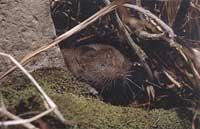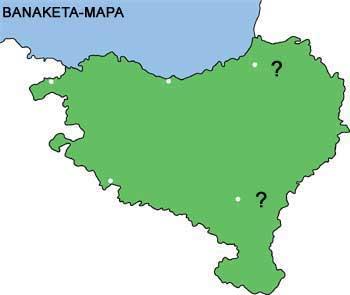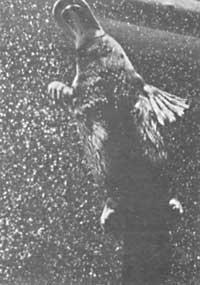Common mole. The little heir of our ancestors
1992/12/01 Aihartza, Joxerra Iturria: Elhuyar aldizkaria

Some 80 million years ago, in the Cretaceous, the great saurians dominated the terrestrial vertebrates. But together with them, or rather, among their enormous claws, they went up and down, in one way and another, maintaining life, the ancestors of mammals, which we are today, are so widespread and diversified.
Those premature mammals were small animals, and their simple teeth indicate that they did not present a trophic specialization that can be characterized in more modern orders created since then. On the contrary, their small sharp teeth suspect that these animals could feed on insects or other invertebrates and massacres, which has led them to classify themselves in the order of the insectivores, along with the present urchins, moles and satiacs.

In the case of the hedgehogs, the development of the envelope of thorns is a remarkable evolutionary additive, of course, and the group of talpids that houses the moles presents special adaptations, especially when it comes to the capacity of underground induction. Therefore, it seems that the group of the believers who form the sattids, within the order of the insectivores, has suffered the least changes in anatomy and early life, and therefore, these curious little animals are heirs of the ancient ancestors of all the pleasantly mammals — the descendants are all, of course — and, as Desmond Morris says, we are so proud that we are so “cursed”.
Sadid, our pleasant cousins, are small and slender animals adapted to live hunting insects from the earth's surface. For its part, the sorician family in which they are grouped is one of the largest groups of mammals in terms of number of species, and brings together the smallest mammals: the largest sated has an approximate weight of 35 g, while the Etruscan sattsu (Suncus etruscus), of 1-2 g, is the smallest of all mammals.
One of the most abundant species in the Basque Country is the common mole (russula Crocidura). This species is a medium-sized mole, with a length of its body between 6 and 9 cm and a weight of between 6 and 14 g. As for its general appearance, it is very similar to the rest of sattids: the color of the skin of soft hair is brown gray from the dorsal part and somewhat lighter, almost whitish, in the ventral part. His eyes are very small, almost invisible, and his end is pointed and mobile, with long and numerous whiskers. The ears are also very small, but not as small as those of the satides of the genus Sorex, which in the case of the common satitsu are expelled considerably between the fur of the head.

As already mentioned, the mole is an animal that lives eating the invertebrates that it finds on earth, and that, as necessary, its anatomy and behavior are completely adapted to that life. Therefore, and although the brain is very small, the lobes related to sense organs are very important. The fact is that sadid people have an enormous capacity to obtain external information: they have extremely demanding smell and hearing, and some species are able to listen to ultrasound, just as bats have been proposed for echolocation. The touch is also very developed, both at the end, thanks to the numerous local whiskers, as in the legs, which have the ability to realize the tremors of the earth.
Thanks to this remarkable development of sense organs, the mole is a great hunter with preys of insects, worms, slugs and rodents, and many other invertebrates.
However, because they are such small animals, and due to the high relationship between their surface and volume, the maintenance of homeothermia is expensive, so they must maintain a high level of metabolism. That is why sadid people have to deal with hunting in order to meet their great metabolic needs. And the common mole has to eat as many pieces of hunting as its weight to survive every day. Therefore, these animals spend all day hunting. However, its maximum level of activity occurs at dusk and dawn.
However, even though the animal is a hunter, and due to its small size, it also feeds on other larger predators. Hontza zuria (Tyto alba), urubia (Strix aluco), erbinudea (Mustela nivalis) and katajineta (Genetta genetta) are the worst enemies. Eventually fox (Vulpes vulpes), viper (Vipera sp. ), and both the wild cat (Felis silvestris) and the homemade cat (Felis catus) also try to escape the mole, but these are not so easy. And it is that the common satitsu, like other satirics, is provided with poisoned salivary glands, which makes it its poisonous bite.

This poison is used in most cases to kill invertebrates that are their own hunt, but if it is in danger it can also be used as a means of defense, and although its influence is not so great, it may be enough to despair some enemies. On the other hand, in its glands adjacent to the tail, it produces another odorous substance that it uses to mark the territory and uses it as a means of defense against the attack of several predators. By these systems, the fox or cat often kills the mole, but does not eat because of its bad smell or taste. The serpent also does the program, but the Satan faces him and makes him sing love.
However, these systems are not always useful and the satin ones are common parts for kangaroos. They are not only hunters but also hunting, which means a high mortality. In addition, and to put it in some way, we have animals that live at high speed, both for their fast metabolism and for their poor survival, since normally they do not arrive more than two winters. And this type of fast life requires a large reproduction capacity to ensure the continuity of the species.
The ugal period of the mole extends from March to November, period in which each female can have two, three or four goats, with an average of 3-6 children per session. Making the beads easily, each satiated female can be launched into the world from 6 to 24 kilometers a year. The mortality rate of these populations has probably also been high, but given that they are able to reproduce within a few months of the birth of the sadid people, the different populations do not have greater problems to advance.

Mole nests under herbaceous plants, bushes or stones. This is a compact sphere always built in grass, which is accessed through a small hole made on one side. Gestation usually takes about 20 days and the offspring born after that time get naked and throw themselves blindly. During the first 25 days of life, young children will accompany their mother, learning to hunt and other tasks. The first days the whole family moves in a row and in a row, in front of the mother, and the offspring behind, each holding the tail of the former with teeth. Within a month each child begins his way.
As for the place of residence of the animal, the common mole has a great flexibility and is undoubtedly an animal that we could find throughout the Basque Country. However, the mole is unforested and prefers meadows, orchards, farmland and pastures to live. As for the climate, it also does not require strict conditions, and it can be said that it adapts perfectly from the humid and temperate zones of the coast to the dry steppes of the bank, although it has no tendency to high altitudes and, therefore, in areas higher than the thousand meters is much less.
As for the geographical distribution of the species, we could find the common mole throughout continental Europe, from Holland to Gibraltar, and eastward to Poland, Hungary and Greece, which also inhabits the islands of North Africa, Israel and the Mediterranean.
Technical information: Common mole species: Crocidura russula.FAMILY:ORDER:
Intectivos.CLASS:
Mammals.

Gai honi buruzko eduki gehiago
Elhuyarrek garatutako teknologia





